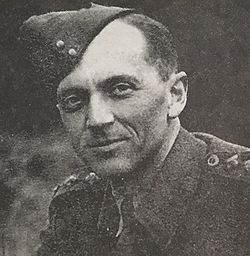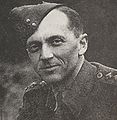Hurdle, Harold Lancelot
| Harold Lancelot Hurdle | |
|---|---|
| 24 April 1910 – 9 Aug 1999 | |
 | |
| Nickname | Hal |
| Place of birth | North Bay, Ontario |
| Place of death | Montreal, Quebec |
| Place of burial | Lakeview Cemetery, Montreal |
| Allegiance | Canada |
| Service/branch | Canadian Army |
| Rank | Lieutenant-Colonel |
| Awards | OBE |
Early Life
Harold was born at North Bay Ontario on 24 April 1910 to Ethelbert and Minnie (nee Barker). The family moved to Edmonton Alberta where his father died in the great influenza epidemic of 1918.[1] He attended the University of Alberta and graduated with a degree in Electrical Engineering in 1933. As it was during the depression, he first worked as a gang boss at the relief camp at Cooking Lake Alberta where a shore based airfield was being constructed. He then worked for Calgary Power as an apprentice engineer, a position that provided him varied experience including climbing poles and working as a grease monkey in a hydro plant albeit for low pay.
Service
During his time at university, Harold was a member of the Canadian Officer Training Corps (COTC) and in 1931 received a Certificate "A" after qualifying in the Signals syllabus of instruction.[2]
In 1940 Lieutenant Hurdle was at Camp Barriefield where he moved between units as the wartime Signals units took shape. In February 1940 he was appointed Adjutant of Army and Line of Communication Signals Sections. He was attached for a period of time to 1 Corps Signals before being transferred in July 1940 to No. 5 Fortress Signal Company, part of Atlantic Command Signals, in Sydney Nova Scotia. As a Captain, in January 1941 he was transferred to 1st Armoured Divisional Signals (which was later redesignated 5 Canadian Armoured Divisional Signals). He was appointed Assistant Adjutant in March 1941, a role he maintained for the unit's move overseas during the later part of 1941. In January 1942 he was posted from Brigade Headquarters Troop of 2 Squadron to the same troop in 3 Squadron. In February 1942 he was appointed Officer Commanding 2 Squadron, 5 Armoured Divisional Signals.
Effective 1 September 1942 he was promoted to the rank of Major and given command of 1st Canadian Armoured Brigade Signals replacing Major Gordon Rolfe who did not return from the Dieppe Raid having been taken prisoner. He remained in command of the unit for Operation Husky, the invasion of Sicily and throughout much of the Italian Campaign.
During the Italian Campaign it was learned that the Germans had found a way to listen to the wireless (radio) communications between the infantry and the tanks of the Armoured Corps. Major Hurdle worked closely with all branches involved in communications and devised a method of radio communication that the Germans could not intercept. Adopted as standard practice for infantry-tank intercommunication, the development was a significant contribution to the success of the campaign. For his work, he was made an Officer of the Order of the British Empire[3].
In November 1944 he relinquished command and returned to Canada to attend a staff course.
From 1954 until 1957 he commanded 11 Signal Regiment in Montreal. He served as President of the Canadian Signals Association from September 1960 until September 1961.
Officer of the Order of the British Empire Citation
The citation card[4] for the Officer of the Order of the British Empire award reads:
- As Officer Commanding 1 Cdn Armd Bde Sigs, Major Hurdle developed the fundamental practices of infantry-tank communications used so effectively through the Italian campaign. His innovations in this field have become standard practice and drill carried out by the Bde. His great technical knowledge, ability and initiative were towers of strength during critical periods in operations. At no time during the campaign did communications falter, with the direct result that contact was maintained always, even under difficult and trying conditions, with the most forward of tank forces. Under his supervision every variety of wireless combination was used with success to fit varying phases of operations. The untiring efforts of this officer contributed directly to the successes won in this period by the Bde.
After Service
After the Second World War Harold worked for Montreal Engineering where he moved up the ladder including a consulting job in Brazil where he was involved in the planning of the complete electricity system in the Southern part of the country. When the province of Quebec nationalized electricity generating companies, Harold spent several years negotiating the take-over of Ottawa Valley Power by Hydro Quebec, working to ensure individual shareholders received fair compensation.
Personal Life
Harold married Margaret Brewer in Quebec City in 1940 and together they had three daughters, Patricia, Susan and Elizabeth. Margaret died in 1961 and Harold later married Helen Runnels in 1966.
Harold died on 9 Aug 1999 and is buried at Lakeview Cemetery, Montreal.





